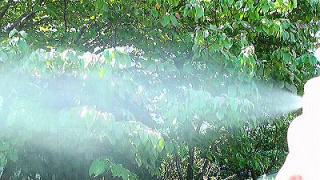Environment and Eneergy Laboratory aims at developing new technologies friendly to global environment.
Ozone -mist and its applications
Ozone mist generation
Ozone
Cold atmospheric plasma has high energetic and reactive species including gas molecules, charged particles in the form of positive ions and negative ions, free radicals and electrons. Recently an emerging technology of cold atmospheric plasma has developed for use in biological ad biomedical applications. Cold plasma processing is an alternative promising technology to chemical agriculture.
Ozone, one of typical reactive matter of cold plasmas, is generated by many types of electric discharges and has high redox potential comparable to fluorine. This property makes it possible to highly react with and destruct many organic compounds. Ozone having shown bacteriacidal, viruscidal and fungicidal actions in certain conditions can destroy all known bacteria, viruses, fungi and insects.
Ozone has attracted much interest in non-chemical technology for agricultural sterilization. Fundamental study has been done to understand the effect of ozone treatment on above microorganisms living at agricultural farms (plants and soil) and production. Choi showed that dielectric barrier discharges in air sterilize E.Coli bacteria with 99.99% effectively and that ozone molecules are the dominant germicidal species. Wang investigated the inactivation efficacy of agricultural products (fresh fruits and vegetables) caused by a direct-current atmospheric cold plasma treatment. It was shown that the 2 min treatment inactivates 80-90% of Salmonella bacteria on the products and that *OH and singlet oxygen are observed in the plasmas. The study on the action of ozone on DNA and RNA molecules has important implications in the disinfection mechanism. The
Ozone-mist

The ozone-mist of this system is generated by injecting high dense ozone gas into treatment space surrounded with water-mist. Chemical reaction between ozone and water in the ozone-mist matter provides ozone derivative radicals such as hydroxyl radical (*OH) and the superoxide ion radical (*O2-) which have high redox potential.
Water-mist was produced by supplying the water to four mist nozzles placed concentrically where a flow rate of water was 300mL/min. High dense ozone was injected into the water-mist through an ozone gas nozzle.
The elementary reactions in the ozone-mist follow:
OH- + O3 →* HO2 + *O2- (1)
*HO2 = H+ + * O2- (2)
*O2- + O3 → O2 + *O3- (3)
*O3- + H+ → HO3 (4)
HO3 → O2 + *OH (5)
O3 + *OH→ *HO2 + O2 (6)
Initially, the superoxide ion radical (*O2-) and the hydroperoxide radical (*HO2) are formed and then lead to the generation of the highly reactive hydroxyl radical (*OH). The ozonide radical ion (*O3-) is formed as an intermediate reaction product.
Applications to agriculture
- Portable sterilization for small scale agriculture
- Geen house farming
- Agricultural soil sterilization
Environmental applications
- Air
- cleaning, purification, deodorization
- Food
- sterilization, stotage, bottle cleaning
- Medical treatment
- sterilization, theraphy
- Drinking water
- sterilization, purification
バナースペース
環境エネルギーラボ
〒810-0074
福岡市中央区大手門1丁目4-15-404 (アトリエ平和台)
TEL(代表):090-8411-6820
e-mail:
ebihara@environment-lab.com
http://environment-lab.com/